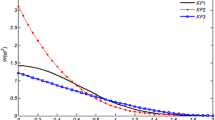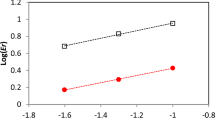Abstract
In this study, SPH formulations are simplified based on straightforward mathematical operations for simulation of free surface flows. Satisfaction of boundary conditions, especially Neumann boundary conditions, is of great importance in accuracy of numerical methods. Employing dummy particles which are placed outside of wall boundaries is one of the simplest methods for imposing Neumann boundary conditions in which pressure of a dummy particle is set to that of a wall particle in the normal direction of the wall boundaries. In fact, dummy particles prevent fluid particles from penetration walls by imposing a repulsive pressure force. In spite of the simplicity of the method, initial placement of several lines of dummy particles can be difficult, especially for non-geometric computational domains. In this research, two different strategies are proposed and employed in which the wall conditions are modeled without the need of dummy particles. In the first strategy, contribution of dummy particles is indirectly included in the numerical computations based on their priori known positions. In the second and main strategy, dummy particles are entirely excluded from the computations and the wall conditions can be modeled only with the wall particles. The efficiency and accuracy of both strategies in modeling of the wall conditions are tested for simulation of dam-break flow using a well-known spline kernel function. It is found that water penetration across the walls is occurred for a certain range of radius of support domain, especially when the second strategy is employed. A new kernel function with steeper shape in comparison with the spline function is introduced here to prevent water penetration even for the second strategy. The efficiency of the proposed kernel function is tested by two free surface problems of dam break and Scott Russell wave generator.



















Similar content being viewed by others
References
Ataie-Ashtiani B, Shobeyri G (2008) Numerical simulation of landslide impulsive waves by incompressible smoothed particle hydrodynamics. Int J Numer Meth Fluids 56(2):209–232
Ataie-Ashtiani B, Shobeyri G, Farhadi L (2008) Modified incompressible SPH method for simulating free surface problems. Fluid Dyn Res 40(9):637–661
Atluri SN, Zhu T (1998) A new meshless local Petrov–Galerkin (MPLG) approach in computational mechanics. Comput Mech 22:117–127
Belytschko T, Lu YY, Gu L (1994) Element-free Galerkin methods. Int J Numer Meth Eng 37:229–256
Bonet J, Kulasegaram S (1999) Variational and momentum preserving aspects of smoothed particle hydrodynamics (SPH) formulations. Comput Methods Appl Mech 180:97–115
Bonet J, Lok T (2000) Correction and stabilization of smoothed particle hydrodynamics methods with applications in metal forming simulations. Int J Numer Methods Eng 47:1189–1214
Chiaki G, Yoshida N (2015) Particle splitting in smoothed particle hydrodynamics based on Voronoi diagram. Mon Not R Astron Soc 451(4):3955–3963
Cueto-Felgueroso L, Colominas I, Mosqueira G (2004) On the Galerkin formulation of the smoothed particle hydrodynamics method. Int J Numer Meth Eng 60(9):1475–1512
Gingold RA, Monaghan JJ (1977) Smoothed particle hydrodynamics: theory and application to non spherical stars. Mon Not R Astron Soc 181:375–389
Gui Q, Dong P, Shao S (2015) Numerical study of PPE source term errors in the incompressible SPH models. Int J Numer Meth Fluids 77(6):358–379
Harlow FH, Welch JE (1965) Numerical calculation of time-dependent viscous incompressible flow of fluid with free surface. J Phys Fluids 8(12):322–332
Heb S, Springel V (2010) Particle hydrodynamics with tessellation techniques. Mon Not R Astron Soc 406(4):2289–2311
Hirt CW, Nichols BD (1981) Volume of fluid (VOF) method for the dynamics of free boundaries. J Comput Phys 39:201–225
Koshizuka S, Oka Y (1996) Moving-particle semi-implicit method for fragmentation of incompressible fluid. Nucl Sci Eng 123:421–434
Koshizuka S, Nobe A, Oka Y (1998) Numerical analysis of breaking waves using the moving particle semi-implicit method. Int J Numer Meth Fluids 26:751–769
Liu GR (2003) Mesh free methods: moving beyond the finite element method. Chemical Rubber, Boca Raton
Liu X, Lin P, Shao S (2014) An ISPH simulation of coupled structure interaction with free surface flows. J Fluids Struct 48:46–61
Lo EYM, Shao SD (2002) Simulation of near-shore solitary wave mechanics by an incompressible SPH method. Appl Ocean Res 24(5):275–286
Martin JC, Moyce WJ (1952) An experimental study of the collapse of liquid columns on a rigid horizontal plane. Philos Trans R Soc Lond Ser A 244:312–324
Monaghan JJ (1994) Simulating free surface flows with SPH. J Comput Phys 110:399–406
Monaghan JJ (1996) Gravity currents and solitary waves. Physica D 98:523–533
Monaghan JJ (2000) SPH without a tensile instability. J Comput Phys 159(2):290–311
Monaghan JJ, Kos A (2000) Scott Russell’s wave generator. Phys Fluids 12:622–630
Monaghan JJ, Kos A, Issa N (2003) Fluid motion generated by impact. J Waterway Port Coast Ocean Eng 129(6):250–259
Onate E, Idelson S, Zienkiewicz OC, Taylorm RL, Sacco C (1996) A stabilized finite point method for analysis of fluid mechanics problems. Comput Methods Appl Mech Eng 139:315–346
Shao SD (2012) Incompressible smoothed particle hydrodynamics simulation of multifluid flows. Int J Numer Meth Fluids 69(11):1715–1735
Shao SD, Lo EYM (2003) Incompressible SPH method for simulating Newtonian and non-Newtonian flows with a free surface. Adv Water Resour 26(7):787–800
Shobeyri G, Afshar MH (2010) Simulating free surface problems using discrete least squares meshless method. Comput Fluids 39:461–470
Shobeyri G, Afshar MH (2012) Corrected discrete least square meshless method for simulating free surface flows. Eng Anal Bound Elem Method 36:1581–1594
Shobeyri G, Ardakani RR (2017) Improving accuracy of SPH method using Voronoi Diagram. Iran J Sci Technol Trans Civ Eng 41:345–350
Sussman M (2003) A second order coupled level set and volume-of-fluid method for computing growth and collapse of vapor bubbles. J Comput Phys 187:110–136
Author information
Authors and Affiliations
Corresponding author
Rights and permissions
About this article
Cite this article
Shobeyri, G. A Simplified SPH Method for Simulation of Free Surface Flows. Iran J Sci Technol Trans Civ Eng 42, 245–258 (2018). https://doi.org/10.1007/s40996-018-0103-6
Received:
Accepted:
Published:
Issue Date:
DOI: https://doi.org/10.1007/s40996-018-0103-6




